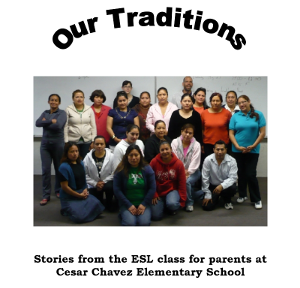Strategies for Using Student Stories
Student stories
I try to make students' lives and experiences the heart of the curriculum. One way is supporting students in telling their stories and then developing lessons around these stories. Stories written by students serve as models for other students and often reveal common tensions and conflicts that can be explored in the class. Not only are they effective launching pads for discussions, analysis and reflection, they can also be transformed into pronunciation, fill-in-the-blank, and comprehension exercises. Students authoring a book on a common issue can turn into a class project. Click below to download student books written by 2 of my previous classes.
"Our Traditions" written by Jeff's low-intermediate ESL class at SCALE May 2012
"Our Experiences" written by Jeff's multi-level family literacy ESL class at Cesar Chavez July 2009
I keep a bank of stories written by students who have given me permission to use them in class. When I introduce a thematic lesson, my opening activity often presents a story written by one of my previous students. The ideal student story is one that explores the student's experience interacting in that thematic context. A good story doesn't provide answers, but raises questions, reactions and reflection. The story can also be turned into a dictation or other activity that focuses on surface level skills. Turning stories into dictations are perfectly suited to differerentiating materials (see sample materials below) according to the different literacy levels of the students. But keep in mind that the real value of a student story is to support other students in critically engaging with it through analysis, reaction, reflection and re-appropriation of its content or structures. Click below to download samples of student story activities.
Student story activity around a job problem
Student story activity around dating traditions
Student presentations
Class and public presentations are other ways for students not only to tell their stories, but also share their knowledge. When students identify an issue to research and present it to an audience that learns from them, then it's an authentic presentation and the students are positioned as researchers and makers of meaning rather than passive learners and/or low level learners. Click below to see powerpoint presentations on community issues that my students presented on their graduation day. See ESL for leadership in the main menu for more information on this class.
TWB student powerpoint presentations on bullying November 2011
TWB student powerpoint presentations on gangs April 2011
Additional resources
Gail Weinstein was a pioneer in using student stories as learning materials which she framed as Learners Lives as Curriculum. Below is a link to the publishing site for an ESL texbook series she wrote.
Collaborations by Gail Weinstein
Isabel Beck and Margaret McKeown developed a teaching approach that supports students in questioning the author and taking other critical positions towards a text. Though their approach targets K-12 students, it's applicable to ESL readers, particularly those with limited literacy skills in their native language.
http://teacher.scholastic.com/products/scholasticprofessional/authors/pd...